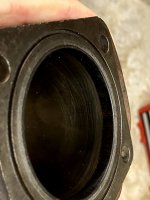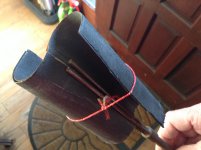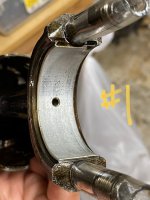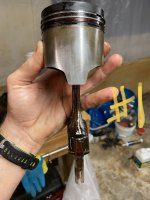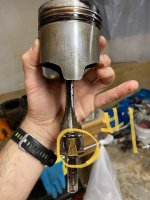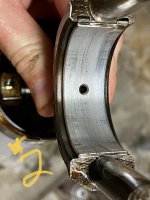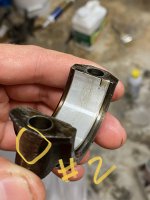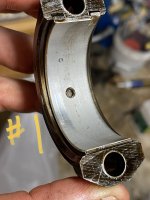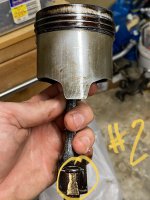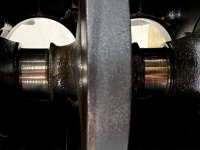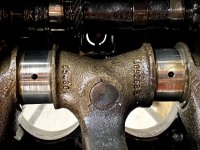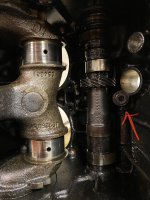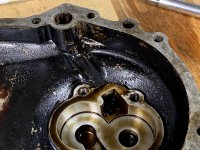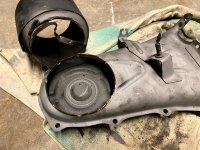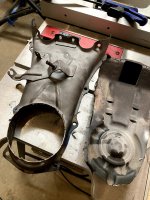I'm a little out of my depth here in that I don't have in depth knowledge of the 500 - I did help my friend look after his back in the early '70's but we never had the engine in pieces. Remember lots of problems with drive shaft splines though!
I do though have quite a bit of experience rebuilding Hillman Imp engines at home in my own garage and also I used to "mess about" a lot with old British motor cycles (so air cooled engines) I find it hard to understand how any running wear could cause the scoring you show in the bore and I'm in agreement with those above who say that it's more likely someone has previously "attacked" it with some, pretty rough, emery? I think you need to give them a light hone and see how they turn out. Doesn't look like there's much of a wear ridge at the top which is good.
I love your DIY hone. I too made one for myself - to be specific I drew up a picture of what I wanted and then my friend who ran courses in hobby lathe use, when I did the evening classes in car maintenance and welding, machine up the triangular "business end" and threaded it concentrically to tale the drive rod. I made the retaining plates for the emery cloth and drilled and tapped the other fixing holes. It works very well indeed and I'm very proud of it!
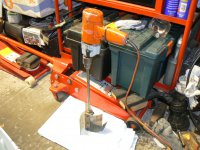
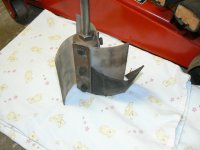
The pistons, from what I can see, look pretty good. I would be giving everything a really good clean up - so the rings need to come off and any deposits in the bottom of the grooves cleaned out. You can use an abrasive paper on the piston crowns and, if you're careful, on the lands between the ring grooves but absolutely not on the piston skirts. This is because some grit from the abrasive is likely to become embedded in the aluminium of the piston and the skirt is in direct contact with the cylinder wall! The piston diameter where the lands are is usually just slightly smaller in diameter, by just a few thou, than the skirt so won't contact the bore wall.
With everything nice and clean check all the dimensions and clearances. First try the pistons in the bores, without rings fitted, gently just by hand, and see if they move full stroke easily without any sign of binding. stop immediately if they bind anywhere to avoid scoring. Then, as suggested above, check with your feelers for skirt to bore clearance as if that checks out OK you don't need to start looking at whether it's pistons or bores which have the wear. Ring gaps need to be checked well down the bore (maybe 3/4 towards the bottom of the bore - never near the top where bore wear will be greatest. - for the same reason the piston skirt to bore clearance should always be checked well down the bore too) also the ring must be absolutely square on to the bore or the gap will not be able to be correctly measured. To achieve this put the ring in the bore and then insert a clean piston upside down - so crown first - into the bore and use this to chase the ring down. This, of course, only works with a piston which had a flat crown! If that all comes out OK then check ring to groove clearances with your feelers.
A rather "strange" wee thing that can catch you out if you find you have a wear ridge at the top of the cylinder but decide it's not enough to warrant a rebore but find your ring gaps indicate new rings would be a good idea is that you may just find you have a small "Knock" after reassembling it with the new rings. What can happen it that the new rings, being completely unworn, will lightly contact the wear ridge when at TDC. It sounds a bit like a worn little end bush. The Anglia engine I rebuilt suffered this and it took me two strip downs to find it. To get over this you can buy ring sets with "Ridge Dodger" top rings. My favourite manufacturer is Cords, here is their brochure which shows the ridge dodger concept:
http://www.mayphil.co.uk/creo_files/upload/files/cords_brochure.pdf
Sorry if I'm telling you "how to suck eggs" above but I've rebuild quite a number of engines - from a 2.0 litre "O" series Ambassador (by gum that was a heavy lump) to several Imp engines, a few "A" series BL units, a 997cc Anglia and a few 2 cylinder DAF "boxer" engines. Also motorcycle and moped engines (the hone would be too big for a moped barrel but probably not relevant as most of them were chromed bores so either absolutely fine to reuse or the chrome surface breaks up and the cylinder is just scrap. There's probably one or two I've forgotten about over the years too. (A VW engine in a beach buggy with head sealing problems comes to mind - that engine doesn't use head gaskets). Your components look, from the pics, to be good enough to reuse. I've used rougher looking components to rebuild everyday "runaround" engines which have subsequently run satisfactorily for years. The big thing has to be cleanliness though - cleanliness is next to ? as the traditional saying goes, and it's never truer than when building engines and gearboxes.
Good luck with it all, do let us all know how it all pans out please - with more pics if possible.


